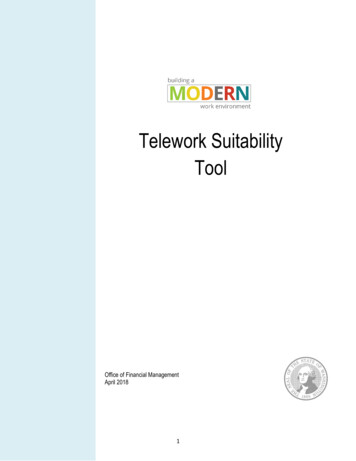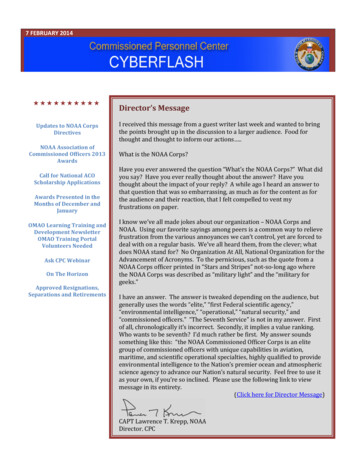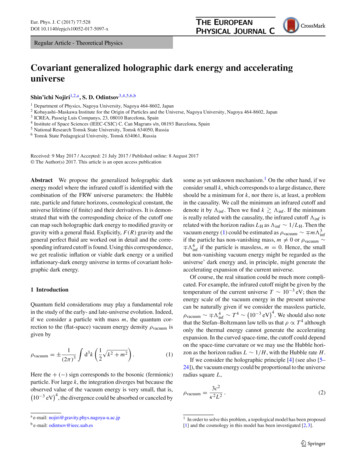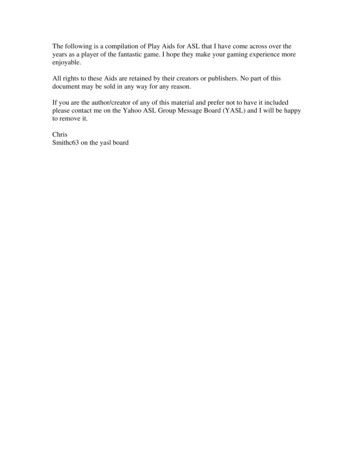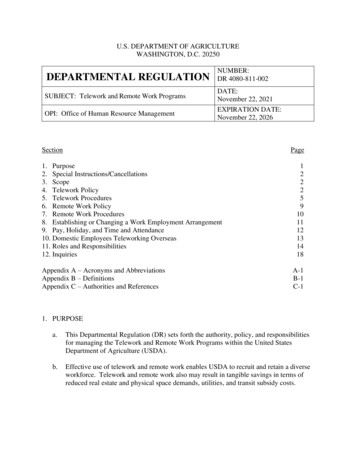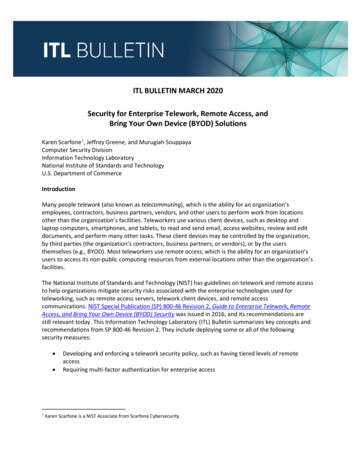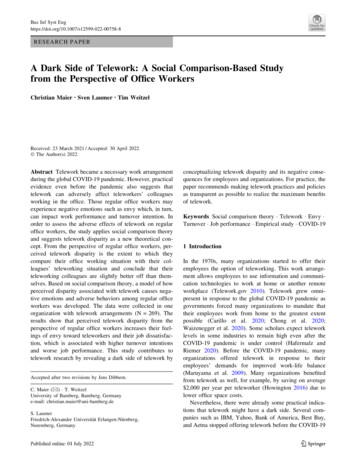
Transcription
Bus Inf Syst RCH PAPERA Dark Side of Telework: A Social Comparison-Based Studyfrom the Perspective of Office WorkersChristian Maier Sven Laumer Tim WeitzelReceived: 23 March 2021 / Accepted: 30 April 2022 The Author(s) 2022Abstract Telework became a necessary work arrangementduring the global COVID-19 pandemic. However, practicalevidence even before the pandemic also suggests thattelework can adversely affect teleworkers’ colleaguesworking in the office. Those regular office workers mayexperience negative emotions such as envy which, in turn,can impact work performance and turnover intention. Inorder to assess the adverse effects of telework on regularoffice workers, the study applies social comparison theoryand suggests telework disparity as a new theoretical concept. From the perspective of regular office workers, perceived telework disparity is the extent to which theycompare their office working situation with their colleagues’ teleworking situation and conclude that theirteleworking colleagues are slightly better off than themselves. Based on social comparison theory, a model of howperceived disparity associated with telework causes negative emotions and adverse behaviors among regular officeworkers was developed. The data were collected in oneorganization with telework arrangements (N 269). Theresults show that perceived telework disparity from theperspective of regular office workers increases their feelings of envy toward teleworkers and their job dissatisfaction, which is associated with higher turnover intentionsand worse job performance. This study contributes totelework research by revealing a dark side of telework byAccepted after two revisions by Jens Dibbern.C. Maier (&) T. WeitzelUniversity of Bamberg, Bamberg, Germanye-mail: christian.maier@uni-bamberg.deS. LaumerFriedrich-Alexander Universität Erlangen-Nürnberg,Nuremberg, Germanyconceptualizing telework disparity and its negative consequences for employees and organizations. For practice, thepaper recommends making telework practices and policiesas transparent as possible to realize the maximum benefitsof telework.Keywords Social comparison theory Telework Envy Turnover Job performance Empirical study COVID-191 IntroductionIn the 1970s, many organizations started to offer theiremployees the option of teleworking. This work arrangement allows employees to use information and communication technologies to work at home or another remoteworkplace (Telework.gov 2010). Telework grew omnipresent in response to the global COVID-19 pandemic asgovernments forced many organizations to mandate thattheir employees work from home to the greatest extentpossible (Carillo et al. 2020; Chong et al. 2020;Waizenegger et al. 2020). Some scholars expect teleworklevels in some industries to remain high even after theCOVID-19 pandemic is under control (Hafermalz andRiemer 2020). Before the COVID-19 pandemic, manyorganizations offered telework in response to theiremployees’ demands for improved work-life balance(Maruyama et al. 2009). Many organizations benefitedfrom telework as well, for example, by saving on average 2,000 per year per teleworker (Howington 2016) due tolower office space costs.Nevertheless, there were already some practical indications that telework might have a dark side. Several companies such as IBM, Yahoo, Bank of America, Best Buy,and Aetna stopped offering telework before the COVID-19123
C. Maier et al.: A Dark Side of Telework: A Social , Bus Inf Syst Engpandemic (Spector 2017; Wright 2017). They aimed toavoid adverse effects, such as increased turnover and lowerperformance among employees who work exclusively inthe office and have teleworkers as colleagues. This paperrefers to such employees as regular office workers. Initialanecdotal evidence indicated that regular office workersmight be envious of the teleworker colleagues (Odenwald2017) and experience greater job dissatisfaction because oftheir colleagues’ teleworking (Wright 2017). It was thoughtthat regular office workers suspected that their teleworkingcolleagues were entertaining themselves, relaxing at home,or taking care of their family at the expense of getting theirwork done. In other words, regular office workers maycompare their office working situation with their colleagues’ teleworking situation. When evaluating this negatively, they potentially perceive envy or jobdissatisfaction, which may, in turn, lead regular officeworkers to be less productive and even develop intentionsto quit their job.Unfortunately, however, the theoretical and empiricalbasis for such concerns is limited. Whether and how telework influences regular office workers adversely in termsof increased turnover or decreased performance remainsspeculative and anecdotal. Nevertheless, this challenge waspresent before the COVID-19 pandemic and has increasedduring it. While media, government officials, or otherinstitutions mainly focus on the benefits of working fromhome and discussing telework as an essential workarrangement for the future, the ones remaining or having toremain in the office tend to be left unnoticed more thanever. Hence, to understand how to implement teleworkwork arrangements successfully and avoid adverse emotional reactions such as envy and job dissatisfaction, it isvital to investigate the adverse effects of teleworking onregular office workers.We aim to provide a theory on how telework influencesregular office workers when comparing their working situation with teleworkers’ working situation. While someteleworkers do all of their work remotely, most teleworkersonly do a percentage of their work remotely. In this study,we differentiate between workers who telework at leastpart-time, whom we refer to here as teleworkers, andworkers who do not telework at all, whom we refer to hereas regular office workers. This study asks:What challenges are generated when regular officeworkers compare their working situation with that ofteleworkers, and how does such comparison affectregular office workers emotionally and behaviorally?To answer this research question, we take the perspective of regular office workers with colleagues who teleworkand draw on social comparison theory (Festinger 1954). Inthis scenario, we propose the concept of telework disparity.123We define perceived telework disparity as a contrast-oriented, upward comparison of a regular office worker withtheir colleagues’ telework. The upward comparison characteristic means that regular office workers comparethemselves with others they consider slightly better offthan themselves. The contrast-oriented characteristic indicates that comparison-induced negative evaluations mayresult in adverse reactions. On the one hand, it models thatregular office workers perceive a high level of monodirectional, telework-related disparity when they perceivethat their colleagues’ working situation is better than theirown as they telework. On the other hand, it models notelework-related disparity when they perceive that theirteleworker colleagues’ working situation is not better ormore beneficial than their own because they telework.Thus, our proposed concept of telework disparity excludespossible perceived disparity in the opposite direction or forother reasons. Our model proposes that perceived teleworkrelated disparity is a potential source of negative emotions,such as envy and job dissatisfaction, and negative behaviors, such as higher turnover intentions and lower jobperformance. To evaluate the proposed research model andtest for the consequences of perceived telework disparityamong regular office workers, we use data collected beforethe COVID-19 pandemic in one organization (N 269)and take a covariance-based structural equation modelingapproach (CBSEM). Our findings confirm our hypothesesand reveal the mediating effect of perceived disparitythrough envy and job dissatisfaction on turnover intentionsand job performance. The importance of the studied topicis confirmed in an applicability check via interviews withregular office workers, teleworkers, and company representatives conducted before and since the outbreak of theCOVID-19 pandemic. This study contributes theoreticallyby introducing and theorizing telework disparity, identifying a dark side of telework, studying telework from theperspective of regular office workers, and explaining howtelework can influence turnover intentions and job performance among regular office workers. These contributionsare essential when organizations want to offer telework as awork arrangement regularly.2 Literature on Telework and Related Research GapsTelework characterizes ‘‘moving the work to the workersinstead of moving the workers to work’’ (Nilles 1998). It isdefined by the European Union ‘‘as a form of organizingand/or performing work, using information technology, inthe context of an employment contract/relationship, wherework, which could also be performed at the employer’spremises, is carried out away from those premises on aregular basis’’. Telework gives employees increased
C. Maier et al.: A Dark Side of Telework: A Social , Bus Inf Syst Engflexibility by considering work as something employees dorather than a place to go to do work. The increased diffusion of communications and secure server technologyenables employees to work at home while keeping productivity high (Cameron and Webster 2013).Most research on telework (Blount 2015; Raghuramet al. 2010) focuses on the benefits of teleworking (for adetailed review on IS-related research in that stream, seeOnline Appendix C, available online via http://link.springer.com). Research posits that telework is generallygood for society by increasing employability and savingenergy without impairing the economy (Sharit et al. 2009).From an employee perspective, it has been shown thatteleworkers can be more satisfied than regular officeworkers (Morganson et al. 2010) or can more flexiblyrespond to family demands (Golden et al. 2006). Teleworkis a recovery mechanism for teleworkers themselves, as itdecreases work exhaustion (Golden 2006). A meta-analysishas concluded that telework has primarily positive consequences for teleworkers (Gajendran and Harrison 2007).While research into such positive effects is dominant, thisresearch has recently been complemented by findings thattelework also has adverse consequences. For example,research finds that telework can adversely affect careeradvancement (Gajendran and Harrison 2007) and increasesocial and professional isolation (Mulki and Jaramillo2011) through a lack of social contacts with colleagues(Bloom et al. 2015). Furthermore, previous research hasextensively studied telework from a perspective thatfocuses on the conditions that influence perceptions oftelework and the individual consequences of telework. Thepossible effects of telework on regular office workers, incontrast, have received less research attention. In thisstream, we found two papers. First, Ojala et al. (2014) findthat telework negatively affects the family and causesstress for family members. Second, Golden (2007) findsthat the way regular office workers view their teleworkercolleagues might be adversely impacted and that this mightlead them to think about quitting their job.Our review of relevant literature reveals several researchgaps. First, there is only a limited understanding of telework from the regular office worker’s perspective. Thisstudy focuses narrowly on whether and how the emotionsand behaviors of regular office workers are affected byteleworkers. Second, most scholarship has focused on thebenefits of teleworking, largely neglecting its potentialadverse consequences on regular office workers, such asincreased turnover or reduced performance. Interestingly,some large companies had stopped their telework initiatives before the COVID-19 pandemic forced them to lettheir employees work from home again. They feared negative impacts (Spector 2017), such as that telework mightlead to increased turnover intentions or lower jobperformance among regular office workers. We aim toclose these research gaps by applying social comparisontheory, developing the concept of perceived telework disparity, and developing and testing a research model of itsemotional and behavioral consequences on regular officeworkers.3 Theoretical Background: Social Comparison TheoryIndividuals have the inherent tendency to compare themselves with others for self-evaluation and uncertaintyreduction (Festinger 1954; Wood 2016). Since this studyaims to understand how perceived disparity related totelework influences regular office workers’ emotions andbehavior, we chose social comparison theory (Festinger1954). We follow the recommendation of Truex et al.(2006) to adapt theories of other fields to IS research andtake a nominal perspective on the IT artifact. Social comparison theory has two central tenets. First, individuals tendto compare themselves with others they consider slightlybetter off than themselves, reflecting an ‘upward drive’(Buunk and Gibbons 2007). Second, such upward drivesocial comparisons affect individuals both positively andnegatively. On the positive side, the individual may assimilate to the higher standard (Mussweiler and Strack2000; Pelham and Wachsmuth 1995). On the negative side,contrast-oriented comparisons may result in adverse reactions when comparisons reveal negative evaluations(Morse and Gergen 1970). The direction of the comparisondepends on the individual’s objectives in terms of selfenhancement or self-improvement (Collins 1996). Selfenhancement objectives are generally associated withdownward comparisons (Tesser 1984), resulting inenhanced self-image. Self-improvement objectives aregenerally associated with upward comparisons, resulting ingreater skills and abilities (Taylor et al. 2016). Even thoughboth are possible, comparisons are more often contrastthan assimilation-oriented (Mussweiler and Bodenhausen2002). As we aim to understand the adverse effects ofcolleagues doing telework emerging from contrast-orientedcomparison, we focus on such contrast-oriented, upwardcomparisons concerning colleagues who telework. Suchcontrast-oriented, upward comparisons lead regular officeworkers to develop a perceived telework disparity resultingfrom social comparisons.Such comparison-induced disparities influence theindividual in multiple steps (Bamberger and Belogolovsky2017; Lim and Yang 2015). After evaluating whether theyconsider someone slightly better off than themselves,individuals experience emotions, which may lead tobehaviors (see Fig. 1). Previous research provides strongevidence that the negative emotions of envy and123
C. Maier et al.: A Dark Side of Telework: A Social , Bus Inf Syst EngSocial comparison(e.g., perceived teleworkdisparity)Emo onal reac ons(e.g., envy,dissa sfac on)Behavioral reac ons(e.g., turnover behavior,employee performance)Fig. 1 Theoretical perspective on social comparison and its consequencesdissatisfaction are triggered by disparities resulting fromcontrast-oriented, upward comparisons (Bamberger andBelogolovsky 2017; Myers and Crowther 2009). There isalso evidence that such negative emotions may be triggeredif an individual, e.g., a regular office worker, evaluates thesituation as threatening for themself (Lazarus and Folkman1984).Regarding behavioral reactions, research in the strand ofsocial comparison finds that perceived disparity can affectperformance and turnover intention (Hanus and Fox 2015).Since both general management and IS research emphasizethe importance of these behaviors (e.g., Bommer et al.1995; Griffeth et al. 2000; Joseph et al. 2007), this studyalso focuses on these two behaviors. Figure 1 summarizesour theoretical model, which serves as the foundation fordefining the new concept of perceived telework disparityand the research model described in the following.4 Conceptualization of Perceived Telework DisparityFor the context of telework, we use social comparisontheory (Festinger 1954), positing that employees makecontrast-oriented, upward comparisons to show that regularoffice workers compare themselves with their teleworkercolleagues. We focus on regular office workers embeddedin a social network of regular office workers and teleworkers. They can easily compare their working situationwith the working situation of their teleworking colleagues.Such comparisons happen, and regular office workersmight conclude that the working situation for teleworkersis better and/or more beneficial.We define perceived telework disparity as a contrastoriented, upward comparison of a regular office workerwith their colleagues’ telework. In that definition, theupward comparison refers to the fact that regular officeworkers compare their working situation with those ofteleworkers and consider their teleworking colleagues’situation better. For instance, they have more time forfamily or need no travel time. The contrast-orientationcharacteristic reflects that the regular office worker mightdevelop adverse reactions when the comparison confirmsthat others are better off. For instance, regular officeworkers might be less motivated to do their work fast or getenvy. So, the narrow definition of telework disparity refersto regular office workers, who do not telework at all, andtheir perception that their teleworker colleagues are better123off than they are. Based on this definition and in line withsocial comparison theory, perceived telework disparity hastwo major characteristics through the eyes of a regularoffice worker. First, the regular office worker has at leastone colleague who teleworks at least part-time. Second,regular office workers perceive that their teleworking colleagues are better off than them because they telework.When the regular office worker perceives both characteristics, they may perceive telework disparity.We conducted in-depth interviews to conceptualize thenew construct with its described characteristics.1 Weinterviewed six regular office workers with colleagues whotelework at least part-time. The purpose of these interviewswas two-fold. First, we aimed to understand the degree towhich perceived telework disparity exists. Second, weaimed to discover whether such social comparisons resultin emotional and behavioral reactions.Here are interviewees’ statements concerning teleworkdisparity: ‘‘my colleagues who are allowed to work fromhome have a much easier professional and private life. Onthe one hand, they do not notice the stress at work and haveto take on far fewer administrative tasks on short notice,e.g., when the supervisor simply drops in and distributestasks. On the other hand, they are more flexible in theirprivate lives and spend much more time with family andfriends. For example, I cannot have lunch with my childrenat noon’’. Another interviewee complemented, ‘‘I feel like Ihave to process work for my colleagues’’. These exemplarystatements illustrate the contrast-oriented, upward comparison characteristic of perceived telework disparity.Here are examples of statements made by intervieweesconcerning emotional and behavioral reactions: ‘‘I wouldlike nothing better than to be in the situation of my colleagues and also work from home and this makes mejealous and unhappy’’. Another regular office worker said,‘‘it is like a two-tier society, and I wonder if I really want tocontinue working here’’. Similarly, a third interviewee1We interviewed six regular office workers (three men, threewomen; the mean age was 43, ranging from 28 to 55). With aninterview guideline, we questioned regular office workers about theirbeliefs, thoughts, and feelings related to their colleagues who workfrom home at least some of the time. The interviews were conductedby one of the authors and another researcher and lasted between 20and 35 min. We recorded and transcribed each interview and usedthese data as the basis for our qualitative analysis (Fielding andSchreier 2001; Yin 2009) using the software program MaxQDA andto develop an understanding of perceived telework disparity (Mileset al. 2013; Myers 2009).
C. Maier et al.: A Dark Side of Telework: A Social , Bus Inf Syst Engreported, ‘‘in the future, I will also not stress myself out andwork overtime because of my disadvantaged situation’’.Our interviews confirm that regular officer workersperceive an upward comparison-based disparity betweenthemselves and their teleworker colleagues. The interviewsalso demonstrate emotional (e.g., envy indicated by feelingjealous and dissatisfaction indicated by feeling unhappy)and behavioral reactions (e.g., turnover intentions indicatedby wondering about continuing working here and low jobperformance indicated by not stressing out and withoutworking overtime) in response to this perceived teleworkdisparity. This definition and initial validity of the newconcept is the basis for our research model development.5 Research Model DevelopmentWe take a social comparison theory perspective based onour definition of perceived telework disparity (Fig. 1). Weposit that social comparison indicated by relative deprivation influences emotions (e.g., envy, job dissatisfaction)and behavior (e.g., turnover intentions, job performance)(see Fig. 2) as supported by the interviews.5.1 Emotional Reactions as Response to PerceivedTelework DisparityWe start by theorizing that perceived telework disparitycauses emotional reactions. Previous research calls it ‘easyto imagine’ that (upward) social comparisons push envy(Duffy and Shaw 2016). Envy is defined as the degree towhich an individual feels that they lack another’s superiorquality, achievement, or possession and either desire it orwish that the other person lacked it (Cohen-Charash andMueller 2007). In the context of telework, we define envyas the degree to which a regular office worker wants to dotelework like their colleagues. Even though previousresearch has not studied whether a relationship betweenperceived telework disparity and envy exists, similarresearch has validated that envy on the job results fromcomparisons in other contexts, including pay disparitiesSocial comparison(Bamberger and Belogolovsky 2017; Call et al. 2015). Intelework, we know that many organizations are highlytransparent about telework policies (Hunton and Norman2010) and employees know which of their colleagues dotelework and how much of their work time they doremotely. This transparency might foster envy-producingsocial comparisons, as regular office workers can easilycompare themselves with their teleworker colleagues,which typically takes the form of contrast-oriented, upwardcomparison (Bamberger and Belogolovsky 2017). Whenregular office worker compares themselves to someonewhose position they perceive as better and more advantageous because they do telework, they may perceive a discrepancy and relative deprivation, possibly at their ownexpense. This may lead them to perceive envy (Koopmanet al. 2019) and react emotionally, such as by wishing thattheir teleworker colleagues were no longer allowed totelework or that they could telework as well.The comparison in the telework context, which leadsemployees to perceive telework disparity, has an even moresubstantial impact on envy for two reasons. First, whensocial comparisons are based on objective and concretefacts, which is transparent in the case of telework, individuals react with relatively strong emotions (Kahneman2012). Second, employees tend to attribute inordinateinfluence to objective and concrete facts (Tversky andKahneman 1983), making them unlikely to consider perceived disparities or deprivations as possible errors ordistortions and more likely to react with strong emotions.Hence, we hypothesize that:H1 The higher the perceived telework disparity, thehigher the envy toward telework colleagues.Job satisfaction research shows that employees evaluatevarious job elements (Locke 1969) to determine their jobdis/satisfaction. While job satisfaction reflects a positiveperception of a job, job dissatisfaction reflects a negativeaffective orientation toward the job (Vroom 1995). Variousjob characteristics determine the level of job (dis)satisfaction (Hackman and Oldham 1975). The characteristicsof the social network individuals are embedded in are oneEmo onal reac onsBehavioral reac onsH3bEnvyTurnover inten onsH1H4bPericeved teleworkdisparityControlsH3aH2Job dissa sfac onH4aJob performanceFig. 2 Research model123
C. Maier et al.: A Dark Side of Telework: A Social , Bus Inf Syst Engof them. These social networks include colleagues, supervisors, customers, and many others (Charoensukmongkolet al. 2016). Literature from other streams confirms thatsuch effects between different individuals exist (Stoetzeret al. 2009). For instance, conflicts with patients influencethe work-related outcomes of nurses in terms of job dissatisfaction, efficiency, and health (Utriainen and Kyngäs2009).We posit an effect of colleagues’ telework on the jobdissatisfaction of regular office workers, arguing that thecharacteristics of the relationship between office workersand their teleworking colleagues determine the level ofperceived telework disparity by the office worker. This isbased on the fact that much attention has been paid to thepotential adverse effects of telework on teleworkersresulting from their relationship itself. Employees considertelework a primary impediment to effective communication, collaboration, teamwork, and work relationships(Grundmann et al. 2011). This includes perceived communication challenges and potentially missed professionalopportunities (Bailey and Kurland 2002). Khalifa andDavison (2000) point out that when colleagues do telework, regular office workers are also challenged by communication and group cohesion problems. When regularoffice workers evaluate work relationships, includingcommunication, collaboration, and teamwork, as worsenedby their colleagues’ telework, their level of dissatisfactionincreases (Eckhardt et al. 2016). These aspects are triggered by the fact that colleagues’ telework negativelyaffects employees working at the office, making themdissatisfied with their job. We suppose that these effects areexacerbated, as the regular office workers attribute the jobdissatisfaction to the perceived telework disparity, reflecting that their telework colleagues are responsible for thatsituation and consider themselves worse off. With thosetheoretical arguments, we hypothesize that:H2 The higher the perceived telework disparity, thehigher the job dissatisfaction.5.2 Behavioral Reactions as Response to EmotionsBehavioral research informs us that emotions are typicallynot the end-state of an employee’s reaction, as emotionsare considered to influence behavior (Zhang 2013).Focusing on envy and job dissatisfaction as two specificemotions triggered by perceived telework disparity, wealign with previous research and assume that both influenceemployee behavior. We concentrate on turnover intentionand job performance as two behavioral reactions. Both arerelevant to several different organizational success variables (Huselid 1995). Research in the strand of social123comparisons indicates that disparities affect performanceand turnover (e.g., Hanus and Fox 2015; Vidyarthi et al.2010Turnover intention reflects the deliberate and consciouswillingness to quit a job and leave the organization (Tettand Meyer 1993). Research reveals that this willingness is,among others, influenced by emotions such as job satisfaction (Joseph et al. 2007; Maier et al. 2021).Job satisfaction is the main predictor of employeeturnover as theorized and empirically validated by severalstudies (Griffeth et al. 2000; Joseph et al. 2007; Tett andMeyer 1993). In our context of telework, we argue thatperceived telework disparity might change elements of theworkplace and thus contribute to job dissatisfaction andpotential turnover intention. It has been shown that dissatisfaction can be reduced by acquiring new skills(Lukaszewski et al. 2008) or by adapting one’s behavior(Lazarus and Folkman 1987), which employees may shyaway from, reacting instead by increasing their willingnessto quit and leave the organization. Envy stemming fromperceived telework disparity is an unpleasant and uncomfortable emotion related to physical and psychological pain(Duffy et al. 2012). Envy is a powerful emotion withadverse behavioral reactions (Vecchio 2000). This behavior may include higher turnover intention in the workplaceif employees consider quitting an attractive way out of anenvy-inducing situation, a specific adaptation mechanismin response to envy (Lazarus and Folkman 1987). Thus, wehypothesize that:H3a The higher an employee’s job dissatisfaction, thehigher the turnover intention.H3b The higher an employee’s envy, the higher theturnover intention.We know that job performance, defined as the outcomeachieved and accomplished by an employee while working(Anitha 2014), depends on organizational practices, policies, and features. It is central to an organization’s success(Cardy and Leonard 2014). Previous research suggests alarge number of aspects as a determinant for job performance, including work engagement (Salanova et al. 2005),organizational climate (Luthans et al. 2008), and job satisfaction (Mobley 1977). We propose a negative relationship between job dissatisfaction and job performance. Intelework, when employees perceive telework disparity,they feel less satisfied with their job and less motivated(Locke and Latham 2004) to engage in their work or go theextra mile, which may lead to lower job performance.Beyond that, envy is a poison in the working atmosphere(Perini 2014), reducing commitment to supervisors andcolleagues and ultimately impairing job performance(Becker et al. 1996). When employees perceive telework
C. Maier et al.: A Dark Side of Telework: A Social , Bus Inf Syst Eng90%) of the selected 300 regular
can impact work performance and turnover intention. In order to assess the adverse effects of telework on regular office workers, the study applies social comparison theory and suggests telework disparity as a new theoretical con-cept. From the perspective of regular office workers, per-ceived telework disparity is the extent to which they
